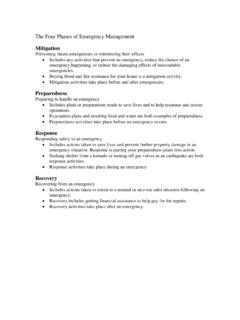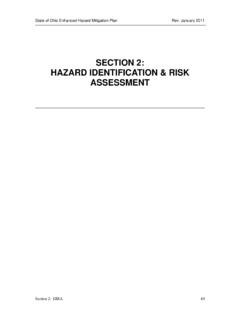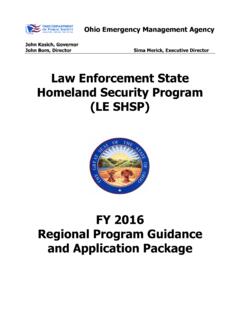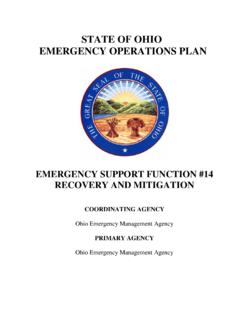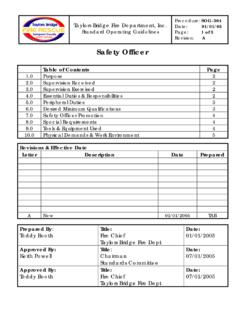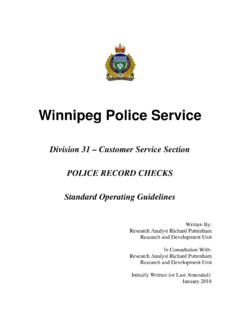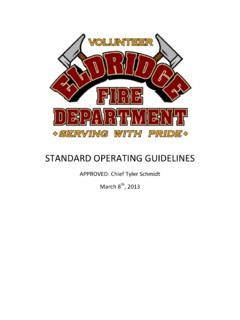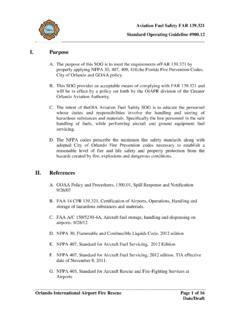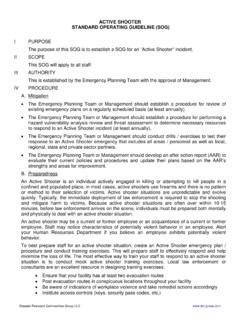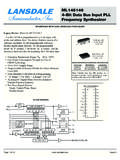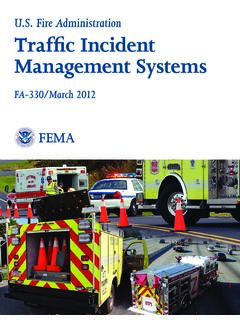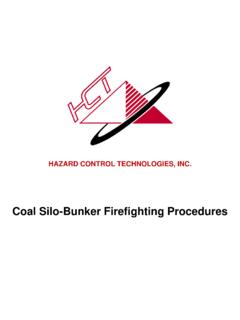Transcription of water sog 3-15-12 - Ohio Emergency Management …
1 Operational guidelines PURPOSE This Operational Guideline will establish standard procedures and considerations for the mitigation of all water rescue/recovery operations. RESPONSIBILITY All Incident Commanders are responsible to comply with and ensure that personnel under their command are adequately trained, fully understand, and comply with this procedure. All Rescue Personnel have the responsibility to learn and follow this procedure. OPERATIONAL GUIDELINE GENERAL SAFETY PRECAUTIONS water Rescue Team members will exercise every safety precaution to afford the highest degree of safety to themselves and victims that is proportionate with the particular hazard situation in which they are operating.
2 Rescue priorities are: a) Self-rescue b) Security of fellow teammates c) Victims The Safety Officer at all incidents involving water should be trained to recognize the additional hazards associated with water -related activities. As a minimum, the Incident Commander should insure the member appointed Safety Officer has been trained to the Technician Level in water rescue, and is trained in water Rescue Procedures. Personal protective equipment Personnel working 10 or less from the water s edge shall have donned the appropriate personal protective equipment (PPE), including personal flotation device (PFD), water rescue helmet, and belted throw bag.
3 Any boat operator entering a boat in the water shall wear at least a Type V PFD and water rescue helmet. Primary and secondary rescuers, and water Safety Team rescuers shall wear Type V PFDs, water rescue helmets, regular throw bag and utilize the waist throw bags, if available, that include flip lines and 55 throw bag inserts. All Fire Department members and other rescue personnel operating at the scene of the water rescue incident should wear a helmet. Fire helmets have no drain holes for water to pass through, and therefore, will not be used.
4 Structural firefighting turnouts and bunker style boots should never be worn on the water s edge, in the boat, or in the water . For law enforcement personnel gear belts and protective vests should be kept away from water area also. Gloves will be worn if the member is actively involved in rescue operations. Flood situations or other contaminated water environments require the use of dry-suits by the primary boat operator and the two primary rescuers. All other protective clothing and equipment will be utilized as deemed necessary by the Incident Commander, the Rescue Sector Officer, Rescuers, or the Safety Officer.
5 Never tie a rope around or on a rescuer except when a water rescue Technician must use a live bait , Type V rescue PFD for a go rescue evolution. Use only the approved steel ring attachment in the back of the PFD for rope attachment. No swift water rescue personnel will perform tasks that are beyond his/her level of expertise. It is expressly forbidden that any swift water rescue personnel enter the water during a swift water rescue operation, without at least a boat, a boat operator, and one other backup swift water rescuer present.
6 Any personnel that does not feel completely confident in the tasks he/she are asked to perform should notify the appropriate supervisor, and refrain from doing the tasks assigned. TACTICAL CONSIDERATIONS Arrive on scene. Take command. Size-up the situation. Secure responsible party or witness. Command should secure a witness as soon as possible after arriving on scene. This will help in identifying and locating the problem the problem. Initiate victim location The first arriving unit will become the Primary Search Team and its officer designated as Search Sector.
7 They will begin to locate and account for all victims. This search team is also known as a Hasty Team and will conduct a search of each bank, checking in and around trees and debris piles for victims. Upon locating victim(s), Command will be notified, and the information used to determine whether rescue or recovery operations should be initiated. Upon arrival of the boat and other units, the Primary Search Team will continue their search. If conditions are such that a victim may be washed downstream faster than the Search Team can travel, additional Search Teams will be assigned well downstream, to a location where resources can be staged before the arrival of the victim.
8 water flow rate, velocity, obstacles, and access will be considered when assigning a downstream Search Team. A Secondary Search Team may be assigned as quickly as conditions allow, moving on both sides of the stream from the last known location toward the downstream Search Team(s). The Search Sector will be terminated when all victims are accounted for, or on the orders of the Incident Commander. Assess the need for additional resources. Command should immediately begin assessing the need for additional resources. If additional resources are necessary, Command should put in an early call for them.
9 If later, it is determined that they are not necessary, Command can put those units back in service. Assess the hazards. Command should do an immediate assessment of the present hazards. Command shall assign the safety officer the Safety Sector. The Safety Sector will be responsible for identifying the hazards present and to have them secured if possible. If it is not possible to secure hazards, Safety Sector will notify all personnel of the hazards and notify Command so that an action plan can be established.
10 Some hazards associated with water rescue operations would be: volume, velocity, and temperature of water , floating debris, unusual drop-offs, hydraulic effects, and depth of water . Select a strategy of "rescue" or "recovery". Based on the conditions present and the hazards to rescuers, Command will have to make the decision to operate in the rescue or recovery mode. If Command determines that the operation will be run in the rescue mode, rescue should begin as soon as possible, and Command should assign an individual as Rescue Sector.
